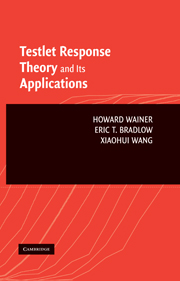Book contents
- Frontmatter
- Contents
- Preface
- PART I INTRODUCTION TO TESTLETS
- PART II BAYESIAN TESTLET RESPONSE THEORY
- 7 A brief history and the basic ideas of modern testlet response theory
- 8 The 2-PL Bayesian testlet model
- 9 The 3-PL Bayesian testlet model
- 10 A Bayesian testlet model for a mixture of binary and polytomous data
- 11 A Bayesian testlet model with covariates
- 12 Testlet nonresponse theory: dealing with missing data
- PART III TWO APPLICATIONS AND A TUTORIAL
- Glossary of terms
- Epilogue
- Bibliography
- Author Index
- Subject Index
12 - Testlet nonresponse theory: dealing with missing data
Published online by Cambridge University Press: 08 January 2010
- Frontmatter
- Contents
- Preface
- PART I INTRODUCTION TO TESTLETS
- PART II BAYESIAN TESTLET RESPONSE THEORY
- 7 A brief history and the basic ideas of modern testlet response theory
- 8 The 2-PL Bayesian testlet model
- 9 The 3-PL Bayesian testlet model
- 10 A Bayesian testlet model for a mixture of binary and polytomous data
- 11 A Bayesian testlet model with covariates
- 12 Testlet nonresponse theory: dealing with missing data
- PART III TWO APPLICATIONS AND A TUTORIAL
- Glossary of terms
- Epilogue
- Bibliography
- Author Index
- Subject Index
Summary
The discussion of test scoring models in the first 11 chapters of this book has been largely theoretical, in the sense that we assumed we were fitting either a complete data set or that the data that were missing were just like the data that we observed. Anyone who has ever had anything to do with a real data collection process knows that this is almost always a fiction. Yet, it is broadly agreed that such an initial approach is sensible. In physics, we begin assuming frictionless movement, simple harmonic oscillations, and nonturbulent flow. Then, once the basic ideas have been mastered, the methods are broadened to accommodate a closer approximation to the broad ramifying reality from which these simplified abbreviations had been so neatly abstracted. So too with testlet theory.
Real data sets are only rarely complete. Sometimes examinees accidentally omit an item, sometimes time runs out before the test can be completed, sometimes the examinee does not know an answer and elects to omit it, and sometimes the examiner elects to administer only a subset of the complete item pool to any specific examinee. In this chapter, we provide a formal way of characterizing missing data, which can help us to know better how we should deal with incomplete data sets.
In our consideration of the situations in which some of the test data are not observed, we suggest various strategies for appropriate inference. We also provide an indication of the effects on the magnitude and direction of the errors that missing data can induce on the validity of inferences that we might draw.
- Type
- Chapter
- Information
- Testlet Response Theory and Its Applications , pp. 186 - 204Publisher: Cambridge University PressPrint publication year: 2007



